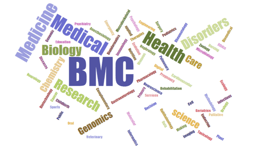World Diabetes Day 2025
Published in General & Internal Medicine and Immunology

November 14 marks World Diabetes Day, a global initiative to raise awareness, share knowledge, and support people living with diabetes. Diabetes is a growing public health challenge, affecting millions worldwide and leading to serious health complications if not managed effectively. This year's theme, ‘Diabetes and well-being,’ focuses on the relationship between diabetes and the workplace and highlights the need for integrated care throughout a person's life, from childhood to older adulthood.
World Diabetes Day is a reminder of the role each of us can play in spreading awareness, improving understanding, and supporting people living with diabetes globally.
As part of a cross-BMC collaboration, we’re highlighting research from BMC Endocrine Disorders and Cardiovascular Diabetology. These studies explore how diabetes affects people’s lives and the progress being made to improve care, self-management, and overall well-being, helping individuals better manage their health and thrive every day. These contributions reflect our commitment to supporting Sustainable Development Goals, with particular focus on SDG 3: "Ensure healthy lives and promote well-being for all ages".

BMC Endocrine Disorders - Evaluating cloudcare, a population health management system, in persons with type 1 diabetes: an observational study
A study published in BMC Endocrine Disorders evaluated CloudCare, a population health management system designed for people with diabetes (PWDs) based on remote monitoring. The authors noted that as diabetes technology advances, the large amount of glucose data generated can challenge healthcare professionals (HCPs) in terms of workflow and timely interpretation. This study aimed to assess how integrating CloudCare into existing care pathways might influence treatment satisfaction, healthcare workload, diabetes-related distress, and glycaemic outcomes among adults with type 1 diabetes.
The study involved a single-centre, prospective observational cohort of adults (n = 119) with type 1 diabetes who had been diagnosed for at least six months before inclusion and were using insulin. Participants were followed for six months after starting CloudCare, with outcomes including treatment satisfaction, contact frequency between PWDs and HCPs, diabetes-related distress, and glycaemic metrics such as time in range (TIR) and glucose management indicator (GMI).
The findings showed that application of CloudCare increased treatment satisfaction, maintained excellent glycaemic control, and decreased face-to-face contacts between PWDs and HCPs. Diabetes-related distress also improved and remained lower at six months. Overall, the findings suggest that CloudCare may help improve treatment satisfaction, reduce HCP workload and maintain glycemic control, supporting its potential role in modern diabetes care.

via Getty Images
Cardiovascular Diabetology - Mitochondrial ultrastructural pathology in diabetic cardiomyopathy: integrated analysis via scanning electron microscopy and 3D visualization imaging
Mitochondrial dysfunction is a key contributor to cardiac impairment in diabetes. A study published in Cardiovascular Diabetology aimed to characterise alterations in mitochondrial ultrastructure (shape, size, cristae integrity), mitochondrial dynamics, and energy‑metabolism impairments in diabetic cardiomyopathy (DCM).
The research used both high-glucose-treated cardiomyocyte models (H9c2 cells) and DCM model mice. Scanning electron microscopy (SEM) and 3D reconstructions quantified mitochondrial length, surface roughness, cristae structure, and mitochondria-associated membrane (MAM) contacts. Molecular analyses measured fusion and fission proteins, mitophagy markers, mitochondrial DNA copy number, ATP content, membrane potential, and respiratory chain complex activity.
The study showed that mitochondria in DCM hearts were fragmented, and showed disrupted cristae and increased MAM contacts. This was accompanied by a lower DNA copy number, reduced ATP production, decreased membrane potential, impaired respiratory chain activity, and elevated oxidative stress. Molecular analysis revealed decreased expression of fusion proteins whereas the fission protein p-Drp1ser616 and autophagy markers PINK1 and Parkin were significantly increased. The authors conclude that ultrastructural remodelling, molecular dysregulation, and bioenergetic failure together form a ‘3D morphology - molecular regulation - metabolic dysfunction’ cascade driving DCM progression.

BMC Endocrine Disorders - Recurrent education: A promising strategy for enhancing diabetes management and reducing hypoglycemia in children with type 1 diabetes
Recurrent individualized education may play a key role in improving diabetes management among children and adolescents with type 1 diabetes (T1D). A study published in BMC Endocrine Disorders by Güneş Kaya and colleagues explored how repeated educational sessions could reduce hypoglycemia unawareness - particularly in those with impaired hypoglycemia awareness (IHA) - and improve overall metabolic control.
In this prospective study, 47 participants aged 8-18 years with T1D were recruited. Three weekly educational sessions covered the hypoglycemia treatment algorithm, symptom recognition, insulin therapy, hyperglycemia, carbohydrate use, glucose monitoring, the exercise- hypoglycemia relationship, and prevention strategies. Continuous glucose monitoring and questionnaire assessments were repeated six weeks after the sessions.
Results showed significant improvements after education, including increased time in range (TIR), better hypoglycemia awareness and self-treatment, reduced hypoglycemia duration, and improved hypoglycemia fear scores. The authors concluded that recurrent diabetes education can enhance glycaemic outcomes and self-management in young people with T1D, supporting its use to reduce severe hypoglycemic events.

Cardiovascular Diabetology - Improving 10-year cardiovascular risk prediction in patients with type 2 diabetes with metabolomics
Cardiovascular disease is a leading cause of mortality in type 2 diabetes in Europe. A study published in Cardiovascular Diabetology by Schöttker and colleagues evaluated whether adding metabolomic biomarkers could improve 10-year prediction of major adverse cardiovascular events (MACE) in adults with type 2 diabetes.
The research used data from the UK Biobank (n = 10,257) and the German ESTHER study (n = 1,039). They measured 249 metabolites using Nuclear Magnetic Resonance (NMR) spectroscopy in blood samples and used sex-specific LASSO regression with bootstrapping to select the metabolites most strongly predictive of MACE.
Seven metabolites were selected as adding predictive value to the baseline model. Key contributors included albumin and omega-3 fatty acids for males and lactate for females. Integration of these metabolites improved the model’s predictive performance. In internal validation with the UK Biobank, the C-index increased from 0.660 to 0.678 (P = 0.037), while in external validation with ESTHER, the increase was +0.043 (P = 0.011).
The authors conclude that adding these metabolomic biomarkers can enhance an established MACE prediction model for patients with type 2 diabetes and that NMR metabolomics may have potential for clinical translation in cardiovascular routine risk assessment.

BMC Endocrine Disorders - Age at type 1 diabetes onset does not influence attained brain volume
A study conducted in Finland by Thorn and colleagues and published in BMC Endocrine Disorders investigated whether the age at which a person develops Type 1 diabetes is associated with their attained brain volume in adulthood.
Adult participants with Type 1 diabetes were recruited from the nationwide Finnish Diabetic Nephropathy (FinnDiane) Study. About two-thirds of the 180 participants had been diagnosed before turning 18. Participants underwent MRI scans to measure their intracranial volume. For gray and white matter analyses, 113 participants were included. They applied fractional polynomial regression to examine the impact of age at disease onset. Models included covariates such as sex, age, height, HbA1c.
The study found that the range of age at diabetes onset was 1.2–39.0 years. There was no statistically significant association between age at T1D onset and intracranial volume (p = 0.85), cerebral white (p = 0.10), and gray matter volumes (p = 0.12). These findings suggest that the age of onset does not appear to influence overall brain growth in a significant way.

Cardiovascular Diabetology - Evaluation of glycemic status and subclinical atherosclerosis in familial hypercholesterolemia subjects with or without LDL receptor mutation
Familial hypercholesterolemia (FH) is a genetic condition characterised by elevated LDL-C levels. A recent study published in Cardiovascular Diabetology by Piro and colleagues examined the impact of genotype on glycemic status and on atherosclerotic injury in FH subjects.
The study involved a cross-sectional analysis of 322 adults (ages 18–70) with a clinical diagnosis of FH, who were not on lipid-lowering therapy and had no prior cardiovascular disease. Participants were classified into two groups according to genotype: LDL receptor (LDLR) group and non-LDLR (NLDLR) group.
The results showed that among people with FH, subjects with NLDLR mutations exhibited a worse glycaemic profile than those in the LDLR group, while subjects with null LDLR mutations had the strongest inverse association with high glycaemic status. Overall, the study highlights that the genetic background of FH influences both metabolic profile and the atherosclerosis distribution, underscoring the importance of combining genetic, lipid, and glucose data.
Follow the Topic
-
Cardiovascular Diabetology

This journal considers manuscripts on all aspects of the diabetes/cardiovascular interrelationship and the metabolic syndrome; this includes clinical, genetic, experimental, pharmacological, epidemiological and molecular biology research.
-
BMC Endocrine Disorders

This is an open access, peer-reviewed journal that considers articles on the characterization, prevention, diagnosis and treatment of endocrine disorders.
Related Collections
With Collections, you can get published faster and increase your visibility.
Organoids as emerging models in diabetes and cardiovascular research
Organoids—three-dimensional structures derived from stem cells—are transforming biomedical research by modeling key aspects of human physiology and disease. By replicating native tissue architecture, cellular heterogeneity, and functional behavior, they provide human-relevant systems that address limitations inherent to conventional in-vitro and animal models.
Diabetes and cardiovascular disease are deeply interconnected conditions, characterized by shared, multi-organ pathophysiology. Organoid technologies offer unique opportunities to dissect disease mechanisms, evaluate therapeutic strategies, and develop personalized, physiologically relevant models. These systems enable the investigation of cardiometabolic processes in platforms that better reflect the complexity and progression of human disease.
Cardiovascular Diabetology welcomes original research articles, reviews, and meta-analyses for this Collection, which aims to highlight the use of organoid technologies in advancing our understanding of cardiovascular complications associated with diabetes.
Areas of interest include, but are not limited to:
- Organoid models of diabetic cardiomyopathy and heart failure
- Matrigel alternatives for organoid development
- Cell-cell and extracellular matrix interactions in organoids
- Organoid-based drug testing for cardiovascular diseases
- Organoid-on-chip systems for tissue crosstalk and perfusion3D bioprinting and tissue engineering for cardiovascular organoids
- Artificial intelligence–driven analysis of organoid function and phenotypes
- Organoid models of gestational diabetes–induced congenital heart disease
- Functional genomics using CRISPR in cardiovascular organoids
- Single-cell and spatial omics to map disease states in organoids
- Co-culture systems of vascular and pancreatic organoids to study metabolic-vascular crosstalk
- Organoid-based screening platforms for anti-diabetic and cardioprotective drugs
Submissions that contribute to conceptual clarity (e.g., distinctions between organoids and spheroids), incorporate multi-organ or metabolic system perspectives, or connect technological development with clinical or translational insights are especially welcome.
This Collection supports and amplifies research related to SDG 3, Good Health and Well-Being.
All submissions in this collection undergo the journal’s standard peer review process. Similarly, all manuscripts authored by a Guest Editor(s) will be handled by the Editor-in-Chief. As an open access publication, this journal levies an article processing fee (details here). We recognize that many key stakeholders may not have access to such resources and are committed to supporting participation in this issue wherever resources are a barrier. For more information about what support may be available, please visit OA funding and support, or email OAfundingpolicy@springernature.com or the Editor-in-Chief.
Publishing Model: Open Access
Deadline: Apr 07, 2026
Diabetes in older adults
BMC Endocrine Disorders is calling for submissions to our Collection, Diabetes in older adults.
The prevalence of diabetes among the elderly population is rapidly increasing, creating a pressing public health concern that warrants extensive research and understanding. As individuals age, physiological changes, including alterations in insulin sensitivity and the presence of comorbidities, complicate diabetes management. Furthermore, the heterogeneous nature of diabetes in older adults often leads to underdiagnosis or misdiagnosis, emphasizing the need for focused research on this demographic. This Collection invites contributions that delve into the various aspects of diabetes in older age, encompassing its pathophysiology, management strategies, and the unique challenges faced by elderly patients.
Understanding diabetes in the elderly is crucial for developing effective treatment protocols and improving quality of life for this vulnerable group. Recent advancements in geriatric care and diabetes management have highlighted the importance of personalized medicine, integrating technology and patient-centered approaches. Research has shown that tailored interventions can significantly enhance glycemic control while minimizing adverse effects, leading to better health outcomes. As the aging population continues to grow, it is imperative that we expand our knowledge base and refine care strategies to meet the needs of elderly individuals with diabetes.
Continued research in this area may lead to groundbreaking advances in the management of diabetes in older adults, including the development of innovative therapies and technologies that cater specifically to their needs. Enhanced understanding of the interplay between aging, diabetes, and comorbidities may also foster more effective strategies for prevention and early intervention. Ultimately, ongoing efforts can pave the way for improved health outcomes and enhanced quality of life for the elderly living with diabetes.
Topics that are welcome include, but are not limited to, the following:
Management strategies for diabetes in older adults
Insulin resistance and aging
Geriatric care approaches for diabetes
Diabetes-related morbidity in the elderly
Evidence-based nutritional therapy
Exercise therapy
This Collection supports and amplifies research related to SDG 3: Good Health & Well-being
All manuscripts submitted to this journal, including those submitted to collections and special issues, are assessed in line with our editorial policies and the journal’s peer-review process. Reviewers and editors are required to declare competing interests and can be excluded from the peer review process if a competing interest exists.
Publishing Model: Open Access
Deadline: Jul 06, 2026


Please sign in or register for FREE
If you are a registered user on Research Communities by Springer Nature, please sign in